Essay: Capabilities and Limitations of Homeland Security in the USA
VerifiedAdded on 2022/08/27
|8
|2007
|14
Essay
AI Summary
This essay examines the capabilities and limitations of Homeland Security, focusing on its role in ensuring the safety of the United States. It begins by highlighting the intelligence-gathering capabilities, including the use of fusion centers, information sharing, and the impact of the USA Patriot Act. The essay then explores the limitations faced by Homeland Security, such as concerns about civil liberties, challenges in information sharing across agencies, and the inability to prevent all threats. The essay emphasizes the importance of a robust intelligence system in combating terrorism and addressing future security threats. It concludes by advocating for continuous improvements in intelligence gathering, information sharing, and adaptation to evolving security challenges, while acknowledging the need to balance security measures with the protection of civil liberties. The essay draws on various sources, including the 9/11 Commission Report and academic research, to support its analysis of Homeland Security's effectiveness and the obstacles it faces.
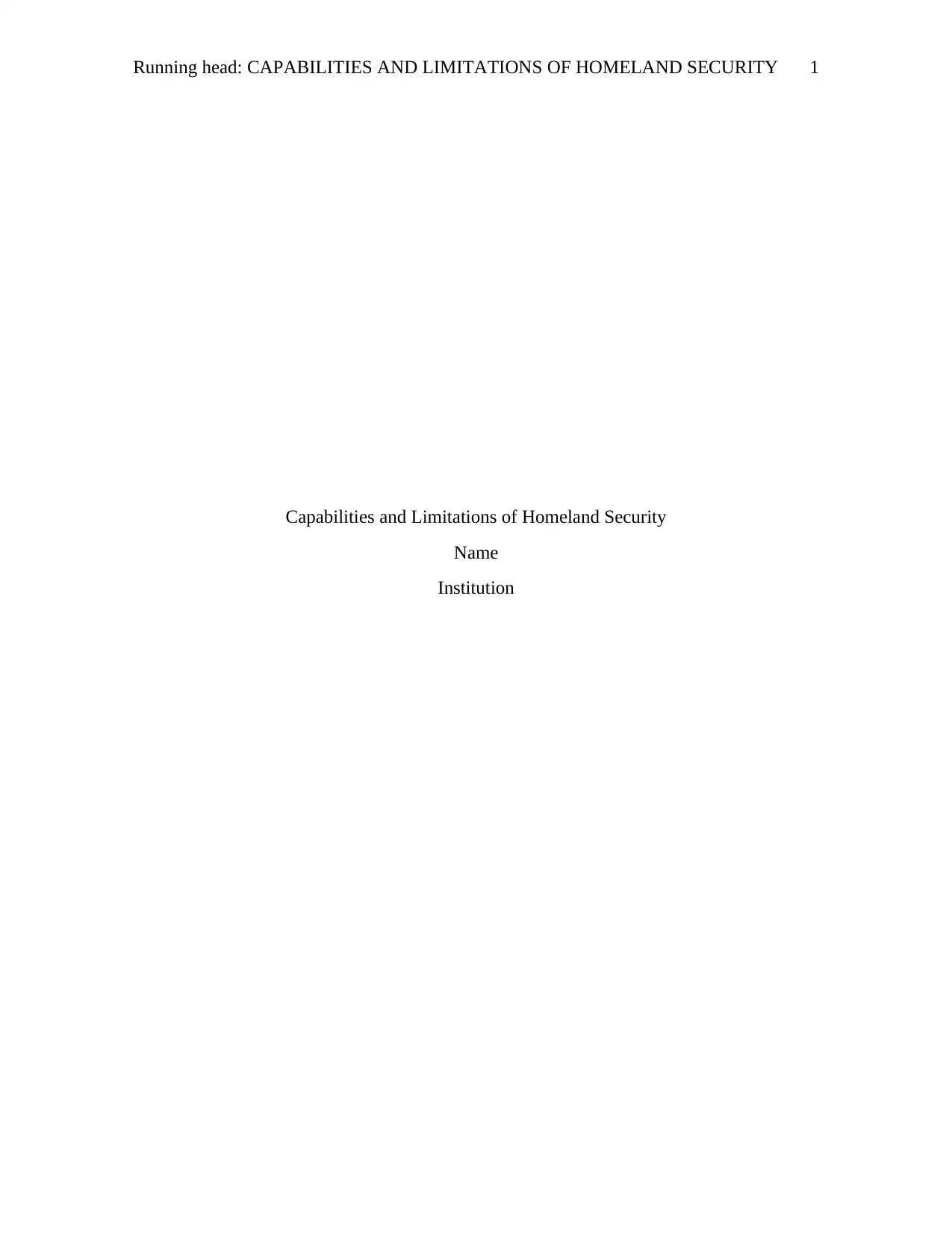
Running head: CAPABILITIES AND LIMITATIONS OF HOMELAND SECURITY 1
Capabilities and Limitations of Homeland Security
Name
Institution
Capabilities and Limitations of Homeland Security
Name
Institution
Paraphrase This Document
Need a fresh take? Get an instant paraphrase of this document with our AI Paraphraser
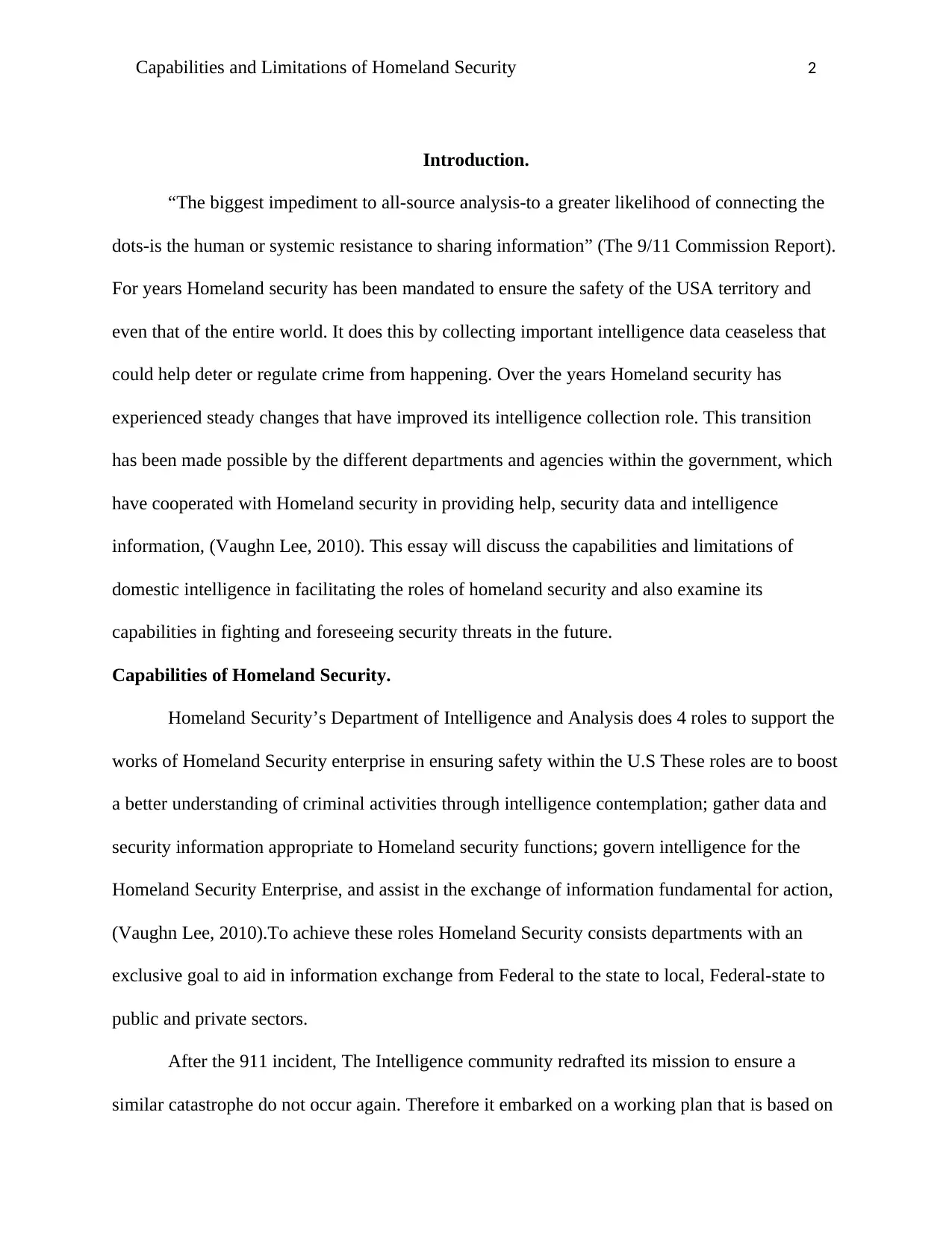
Capabilities and Limitations of Homeland Security 2
Introduction.
“The biggest impediment to all-source analysis-to a greater likelihood of connecting the
dots-is the human or systemic resistance to sharing information” (The 9/11 Commission Report).
For years Homeland security has been mandated to ensure the safety of the USA territory and
even that of the entire world. It does this by collecting important intelligence data ceaseless that
could help deter or regulate crime from happening. Over the years Homeland security has
experienced steady changes that have improved its intelligence collection role. This transition
has been made possible by the different departments and agencies within the government, which
have cooperated with Homeland security in providing help, security data and intelligence
information, (Vaughn Lee, 2010). This essay will discuss the capabilities and limitations of
domestic intelligence in facilitating the roles of homeland security and also examine its
capabilities in fighting and foreseeing security threats in the future.
Capabilities of Homeland Security.
Homeland Security’s Department of Intelligence and Analysis does 4 roles to support the
works of Homeland Security enterprise in ensuring safety within the U.S These roles are to boost
a better understanding of criminal activities through intelligence contemplation; gather data and
security information appropriate to Homeland security functions; govern intelligence for the
Homeland Security Enterprise, and assist in the exchange of information fundamental for action,
(Vaughn Lee, 2010).To achieve these roles Homeland Security consists departments with an
exclusive goal to aid in information exchange from Federal to the state to local, Federal-state to
public and private sectors.
After the 911 incident, The Intelligence community redrafted its mission to ensure a
similar catastrophe do not occur again. Therefore it embarked on a working plan that is based on
Introduction.
“The biggest impediment to all-source analysis-to a greater likelihood of connecting the
dots-is the human or systemic resistance to sharing information” (The 9/11 Commission Report).
For years Homeland security has been mandated to ensure the safety of the USA territory and
even that of the entire world. It does this by collecting important intelligence data ceaseless that
could help deter or regulate crime from happening. Over the years Homeland security has
experienced steady changes that have improved its intelligence collection role. This transition
has been made possible by the different departments and agencies within the government, which
have cooperated with Homeland security in providing help, security data and intelligence
information, (Vaughn Lee, 2010). This essay will discuss the capabilities and limitations of
domestic intelligence in facilitating the roles of homeland security and also examine its
capabilities in fighting and foreseeing security threats in the future.
Capabilities of Homeland Security.
Homeland Security’s Department of Intelligence and Analysis does 4 roles to support the
works of Homeland Security enterprise in ensuring safety within the U.S These roles are to boost
a better understanding of criminal activities through intelligence contemplation; gather data and
security information appropriate to Homeland security functions; govern intelligence for the
Homeland Security Enterprise, and assist in the exchange of information fundamental for action,
(Vaughn Lee, 2010).To achieve these roles Homeland Security consists departments with an
exclusive goal to aid in information exchange from Federal to the state to local, Federal-state to
public and private sectors.
After the 911 incident, The Intelligence community redrafted its mission to ensure a
similar catastrophe do not occur again. Therefore it embarked on a working plan that is based on
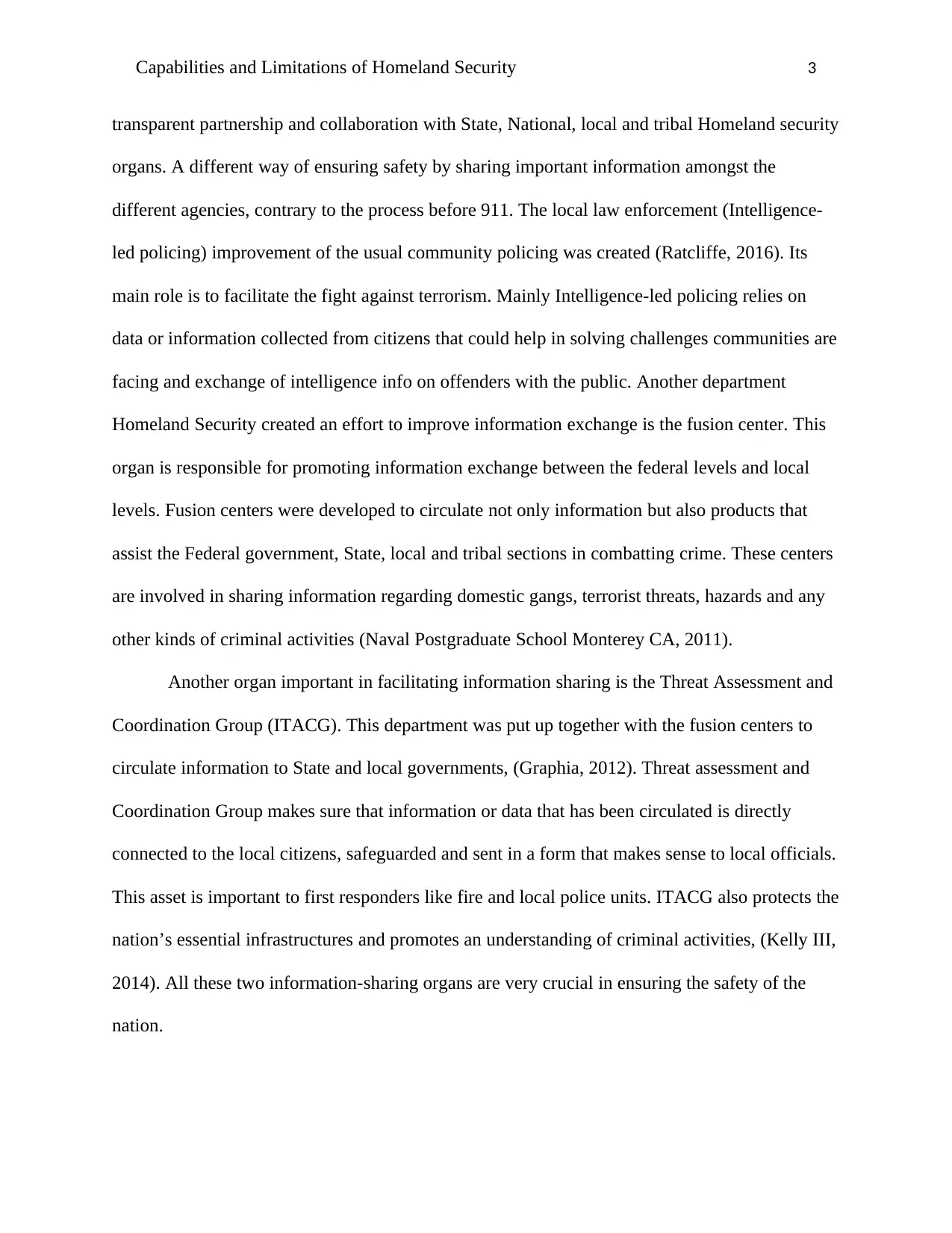
Capabilities and Limitations of Homeland Security 3
transparent partnership and collaboration with State, National, local and tribal Homeland security
organs. A different way of ensuring safety by sharing important information amongst the
different agencies, contrary to the process before 911. The local law enforcement (Intelligence-
led policing) improvement of the usual community policing was created (Ratcliffe, 2016). Its
main role is to facilitate the fight against terrorism. Mainly Intelligence-led policing relies on
data or information collected from citizens that could help in solving challenges communities are
facing and exchange of intelligence info on offenders with the public. Another department
Homeland Security created an effort to improve information exchange is the fusion center. This
organ is responsible for promoting information exchange between the federal levels and local
levels. Fusion centers were developed to circulate not only information but also products that
assist the Federal government, State, local and tribal sections in combatting crime. These centers
are involved in sharing information regarding domestic gangs, terrorist threats, hazards and any
other kinds of criminal activities (Naval Postgraduate School Monterey CA, 2011).
Another organ important in facilitating information sharing is the Threat Assessment and
Coordination Group (ITACG). This department was put up together with the fusion centers to
circulate information to State and local governments, (Graphia, 2012). Threat assessment and
Coordination Group makes sure that information or data that has been circulated is directly
connected to the local citizens, safeguarded and sent in a form that makes sense to local officials.
This asset is important to first responders like fire and local police units. ITACG also protects the
nation’s essential infrastructures and promotes an understanding of criminal activities, (Kelly III,
2014). All these two information-sharing organs are very crucial in ensuring the safety of the
nation.
transparent partnership and collaboration with State, National, local and tribal Homeland security
organs. A different way of ensuring safety by sharing important information amongst the
different agencies, contrary to the process before 911. The local law enforcement (Intelligence-
led policing) improvement of the usual community policing was created (Ratcliffe, 2016). Its
main role is to facilitate the fight against terrorism. Mainly Intelligence-led policing relies on
data or information collected from citizens that could help in solving challenges communities are
facing and exchange of intelligence info on offenders with the public. Another department
Homeland Security created an effort to improve information exchange is the fusion center. This
organ is responsible for promoting information exchange between the federal levels and local
levels. Fusion centers were developed to circulate not only information but also products that
assist the Federal government, State, local and tribal sections in combatting crime. These centers
are involved in sharing information regarding domestic gangs, terrorist threats, hazards and any
other kinds of criminal activities (Naval Postgraduate School Monterey CA, 2011).
Another organ important in facilitating information sharing is the Threat Assessment and
Coordination Group (ITACG). This department was put up together with the fusion centers to
circulate information to State and local governments, (Graphia, 2012). Threat assessment and
Coordination Group makes sure that information or data that has been circulated is directly
connected to the local citizens, safeguarded and sent in a form that makes sense to local officials.
This asset is important to first responders like fire and local police units. ITACG also protects the
nation’s essential infrastructures and promotes an understanding of criminal activities, (Kelly III,
2014). All these two information-sharing organs are very crucial in ensuring the safety of the
nation.
⊘ This is a preview!⊘
Do you want full access?
Subscribe today to unlock all pages.

Trusted by 1+ million students worldwide
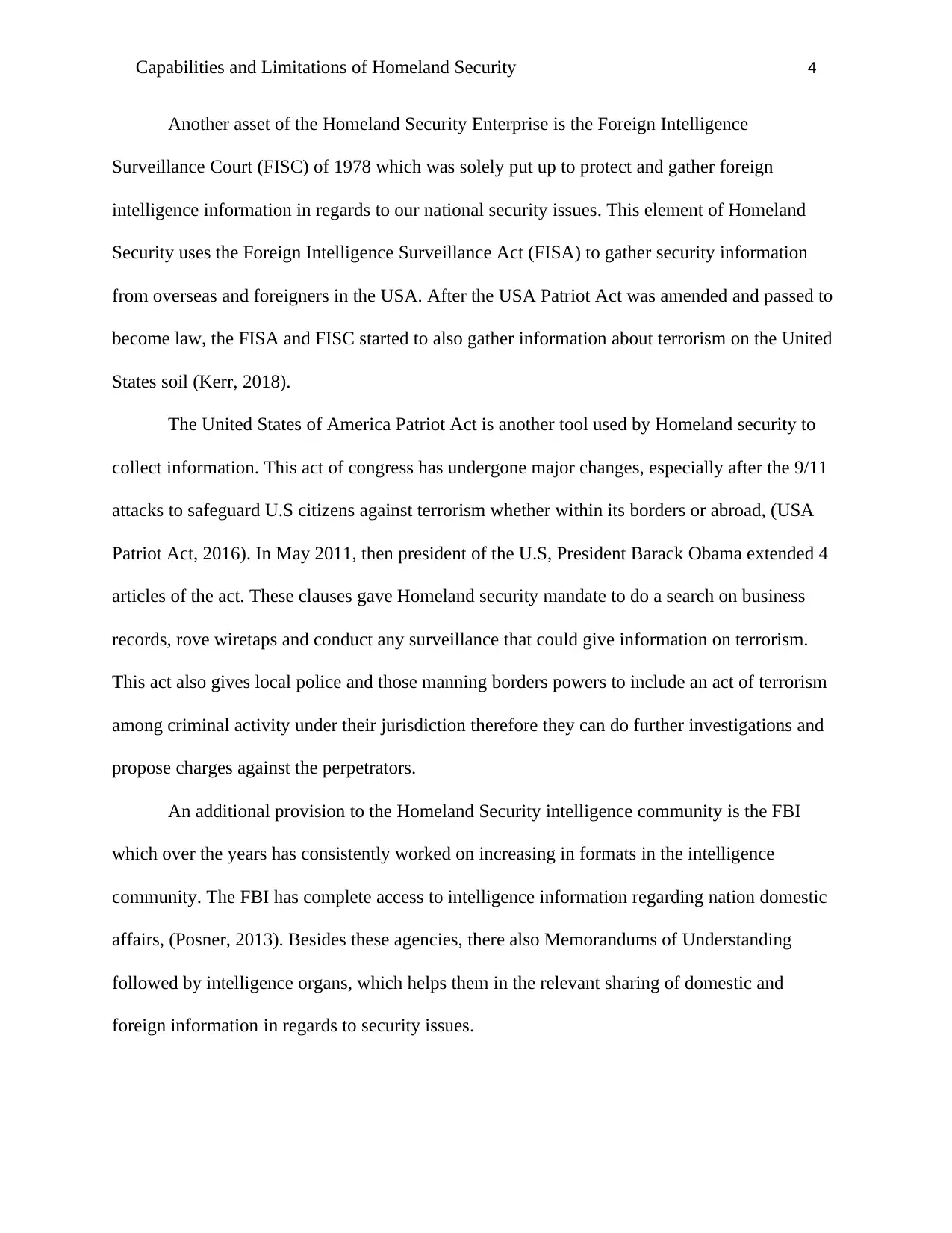
Capabilities and Limitations of Homeland Security 4
Another asset of the Homeland Security Enterprise is the Foreign Intelligence
Surveillance Court (FISC) of 1978 which was solely put up to protect and gather foreign
intelligence information in regards to our national security issues. This element of Homeland
Security uses the Foreign Intelligence Surveillance Act (FISA) to gather security information
from overseas and foreigners in the USA. After the USA Patriot Act was amended and passed to
become law, the FISA and FISC started to also gather information about terrorism on the United
States soil (Kerr, 2018).
The United States of America Patriot Act is another tool used by Homeland security to
collect information. This act of congress has undergone major changes, especially after the 9/11
attacks to safeguard U.S citizens against terrorism whether within its borders or abroad, (USA
Patriot Act, 2016). In May 2011, then president of the U.S, President Barack Obama extended 4
articles of the act. These clauses gave Homeland security mandate to do a search on business
records, rove wiretaps and conduct any surveillance that could give information on terrorism.
This act also gives local police and those manning borders powers to include an act of terrorism
among criminal activity under their jurisdiction therefore they can do further investigations and
propose charges against the perpetrators.
An additional provision to the Homeland Security intelligence community is the FBI
which over the years has consistently worked on increasing in formats in the intelligence
community. The FBI has complete access to intelligence information regarding nation domestic
affairs, (Posner, 2013). Besides these agencies, there also Memorandums of Understanding
followed by intelligence organs, which helps them in the relevant sharing of domestic and
foreign information in regards to security issues.
Another asset of the Homeland Security Enterprise is the Foreign Intelligence
Surveillance Court (FISC) of 1978 which was solely put up to protect and gather foreign
intelligence information in regards to our national security issues. This element of Homeland
Security uses the Foreign Intelligence Surveillance Act (FISA) to gather security information
from overseas and foreigners in the USA. After the USA Patriot Act was amended and passed to
become law, the FISA and FISC started to also gather information about terrorism on the United
States soil (Kerr, 2018).
The United States of America Patriot Act is another tool used by Homeland security to
collect information. This act of congress has undergone major changes, especially after the 9/11
attacks to safeguard U.S citizens against terrorism whether within its borders or abroad, (USA
Patriot Act, 2016). In May 2011, then president of the U.S, President Barack Obama extended 4
articles of the act. These clauses gave Homeland security mandate to do a search on business
records, rove wiretaps and conduct any surveillance that could give information on terrorism.
This act also gives local police and those manning borders powers to include an act of terrorism
among criminal activity under their jurisdiction therefore they can do further investigations and
propose charges against the perpetrators.
An additional provision to the Homeland Security intelligence community is the FBI
which over the years has consistently worked on increasing in formats in the intelligence
community. The FBI has complete access to intelligence information regarding nation domestic
affairs, (Posner, 2013). Besides these agencies, there also Memorandums of Understanding
followed by intelligence organs, which helps them in the relevant sharing of domestic and
foreign information in regards to security issues.
Paraphrase This Document
Need a fresh take? Get an instant paraphrase of this document with our AI Paraphraser
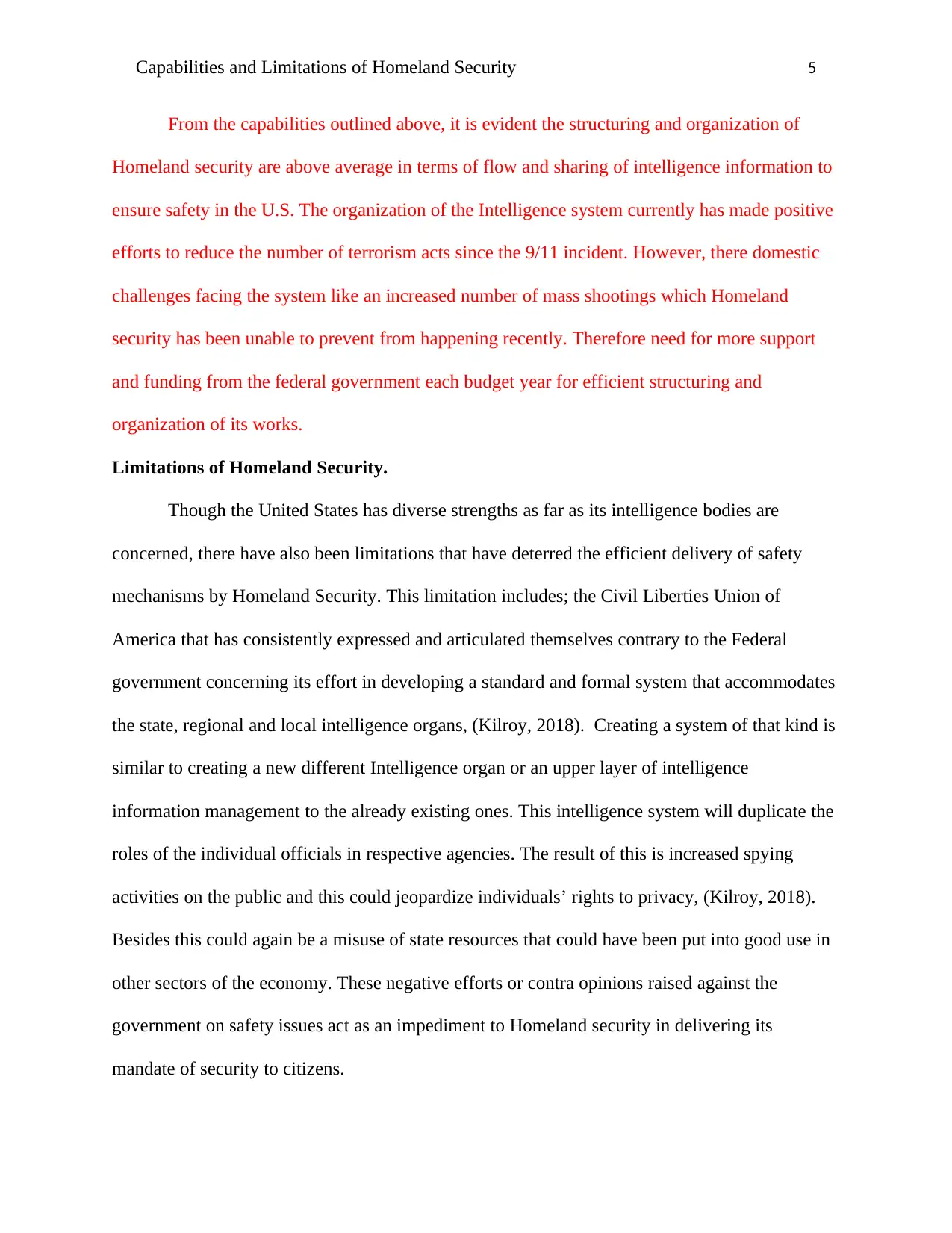
Capabilities and Limitations of Homeland Security 5
From the capabilities outlined above, it is evident the structuring and organization of
Homeland security are above average in terms of flow and sharing of intelligence information to
ensure safety in the U.S. The organization of the Intelligence system currently has made positive
efforts to reduce the number of terrorism acts since the 9/11 incident. However, there domestic
challenges facing the system like an increased number of mass shootings which Homeland
security has been unable to prevent from happening recently. Therefore need for more support
and funding from the federal government each budget year for efficient structuring and
organization of its works.
Limitations of Homeland Security.
Though the United States has diverse strengths as far as its intelligence bodies are
concerned, there have also been limitations that have deterred the efficient delivery of safety
mechanisms by Homeland Security. This limitation includes; the Civil Liberties Union of
America that has consistently expressed and articulated themselves contrary to the Federal
government concerning its effort in developing a standard and formal system that accommodates
the state, regional and local intelligence organs, (Kilroy, 2018). Creating a system of that kind is
similar to creating a new different Intelligence organ or an upper layer of intelligence
information management to the already existing ones. This intelligence system will duplicate the
roles of the individual officials in respective agencies. The result of this is increased spying
activities on the public and this could jeopardize individuals’ rights to privacy, (Kilroy, 2018).
Besides this could again be a misuse of state resources that could have been put into good use in
other sectors of the economy. These negative efforts or contra opinions raised against the
government on safety issues act as an impediment to Homeland security in delivering its
mandate of security to citizens.
From the capabilities outlined above, it is evident the structuring and organization of
Homeland security are above average in terms of flow and sharing of intelligence information to
ensure safety in the U.S. The organization of the Intelligence system currently has made positive
efforts to reduce the number of terrorism acts since the 9/11 incident. However, there domestic
challenges facing the system like an increased number of mass shootings which Homeland
security has been unable to prevent from happening recently. Therefore need for more support
and funding from the federal government each budget year for efficient structuring and
organization of its works.
Limitations of Homeland Security.
Though the United States has diverse strengths as far as its intelligence bodies are
concerned, there have also been limitations that have deterred the efficient delivery of safety
mechanisms by Homeland Security. This limitation includes; the Civil Liberties Union of
America that has consistently expressed and articulated themselves contrary to the Federal
government concerning its effort in developing a standard and formal system that accommodates
the state, regional and local intelligence organs, (Kilroy, 2018). Creating a system of that kind is
similar to creating a new different Intelligence organ or an upper layer of intelligence
information management to the already existing ones. This intelligence system will duplicate the
roles of the individual officials in respective agencies. The result of this is increased spying
activities on the public and this could jeopardize individuals’ rights to privacy, (Kilroy, 2018).
Besides this could again be a misuse of state resources that could have been put into good use in
other sectors of the economy. These negative efforts or contra opinions raised against the
government on safety issues act as an impediment to Homeland security in delivering its
mandate of security to citizens.
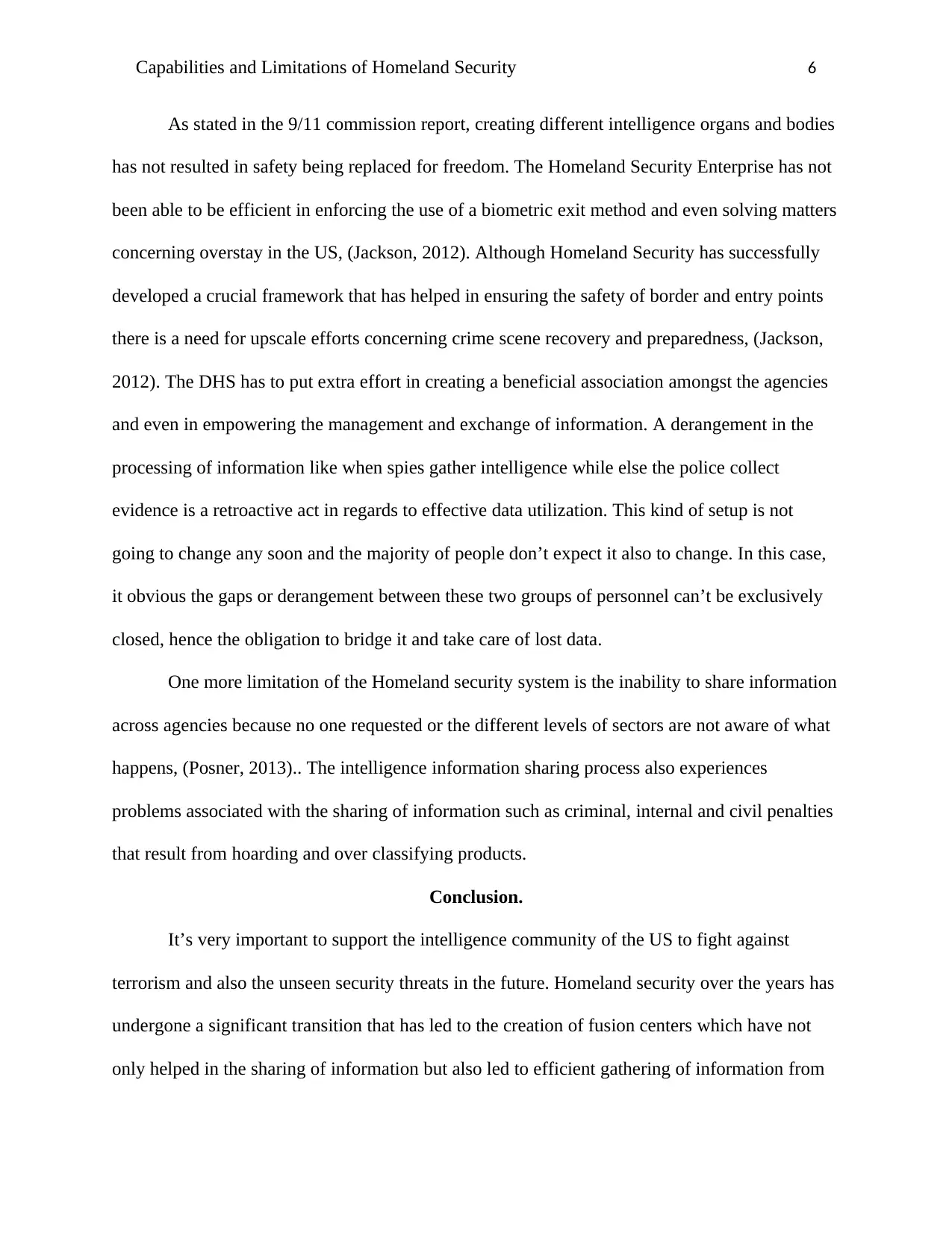
Capabilities and Limitations of Homeland Security 6
As stated in the 9/11 commission report, creating different intelligence organs and bodies
has not resulted in safety being replaced for freedom. The Homeland Security Enterprise has not
been able to be efficient in enforcing the use of a biometric exit method and even solving matters
concerning overstay in the US, (Jackson, 2012). Although Homeland Security has successfully
developed a crucial framework that has helped in ensuring the safety of border and entry points
there is a need for upscale efforts concerning crime scene recovery and preparedness, (Jackson,
2012). The DHS has to put extra effort in creating a beneficial association amongst the agencies
and even in empowering the management and exchange of information. A derangement in the
processing of information like when spies gather intelligence while else the police collect
evidence is a retroactive act in regards to effective data utilization. This kind of setup is not
going to change any soon and the majority of people don’t expect it also to change. In this case,
it obvious the gaps or derangement between these two groups of personnel can’t be exclusively
closed, hence the obligation to bridge it and take care of lost data.
One more limitation of the Homeland security system is the inability to share information
across agencies because no one requested or the different levels of sectors are not aware of what
happens, (Posner, 2013).. The intelligence information sharing process also experiences
problems associated with the sharing of information such as criminal, internal and civil penalties
that result from hoarding and over classifying products.
Conclusion.
It’s very important to support the intelligence community of the US to fight against
terrorism and also the unseen security threats in the future. Homeland security over the years has
undergone a significant transition that has led to the creation of fusion centers which have not
only helped in the sharing of information but also led to efficient gathering of information from
As stated in the 9/11 commission report, creating different intelligence organs and bodies
has not resulted in safety being replaced for freedom. The Homeland Security Enterprise has not
been able to be efficient in enforcing the use of a biometric exit method and even solving matters
concerning overstay in the US, (Jackson, 2012). Although Homeland Security has successfully
developed a crucial framework that has helped in ensuring the safety of border and entry points
there is a need for upscale efforts concerning crime scene recovery and preparedness, (Jackson,
2012). The DHS has to put extra effort in creating a beneficial association amongst the agencies
and even in empowering the management and exchange of information. A derangement in the
processing of information like when spies gather intelligence while else the police collect
evidence is a retroactive act in regards to effective data utilization. This kind of setup is not
going to change any soon and the majority of people don’t expect it also to change. In this case,
it obvious the gaps or derangement between these two groups of personnel can’t be exclusively
closed, hence the obligation to bridge it and take care of lost data.
One more limitation of the Homeland security system is the inability to share information
across agencies because no one requested or the different levels of sectors are not aware of what
happens, (Posner, 2013).. The intelligence information sharing process also experiences
problems associated with the sharing of information such as criminal, internal and civil penalties
that result from hoarding and over classifying products.
Conclusion.
It’s very important to support the intelligence community of the US to fight against
terrorism and also the unseen security threats in the future. Homeland security over the years has
undergone a significant transition that has led to the creation of fusion centers which have not
only helped in the sharing of information but also led to efficient gathering of information from
⊘ This is a preview!⊘
Do you want full access?
Subscribe today to unlock all pages.

Trusted by 1+ million students worldwide
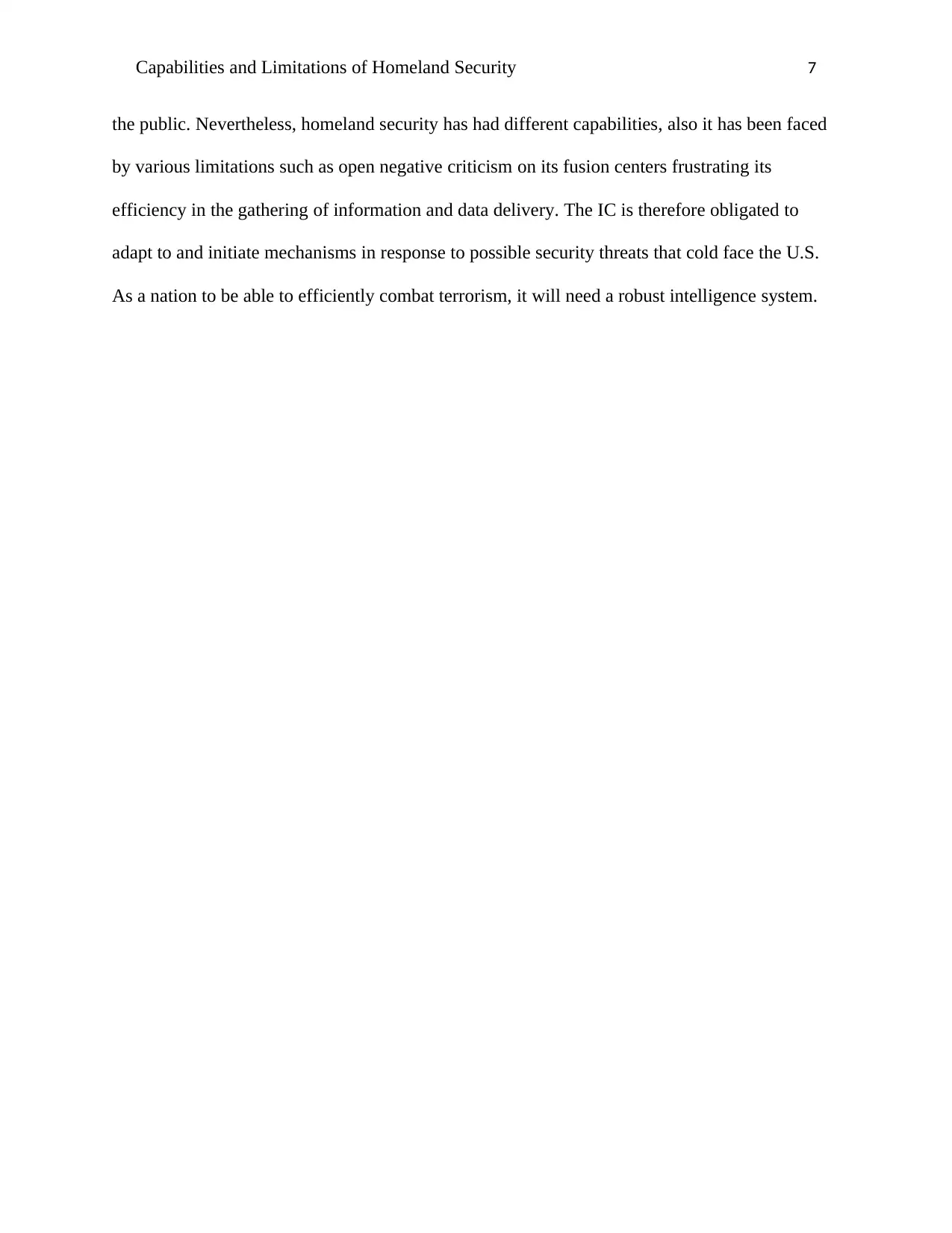
Capabilities and Limitations of Homeland Security 7
the public. Nevertheless, homeland security has had different capabilities, also it has been faced
by various limitations such as open negative criticism on its fusion centers frustrating its
efficiency in the gathering of information and data delivery. The IC is therefore obligated to
adapt to and initiate mechanisms in response to possible security threats that cold face the U.S.
As a nation to be able to efficiently combat terrorism, it will need a robust intelligence system.
the public. Nevertheless, homeland security has had different capabilities, also it has been faced
by various limitations such as open negative criticism on its fusion centers frustrating its
efficiency in the gathering of information and data delivery. The IC is therefore obligated to
adapt to and initiate mechanisms in response to possible security threats that cold face the U.S.
As a nation to be able to efficiently combat terrorism, it will need a robust intelligence system.
Paraphrase This Document
Need a fresh take? Get an instant paraphrase of this document with our AI Paraphraser
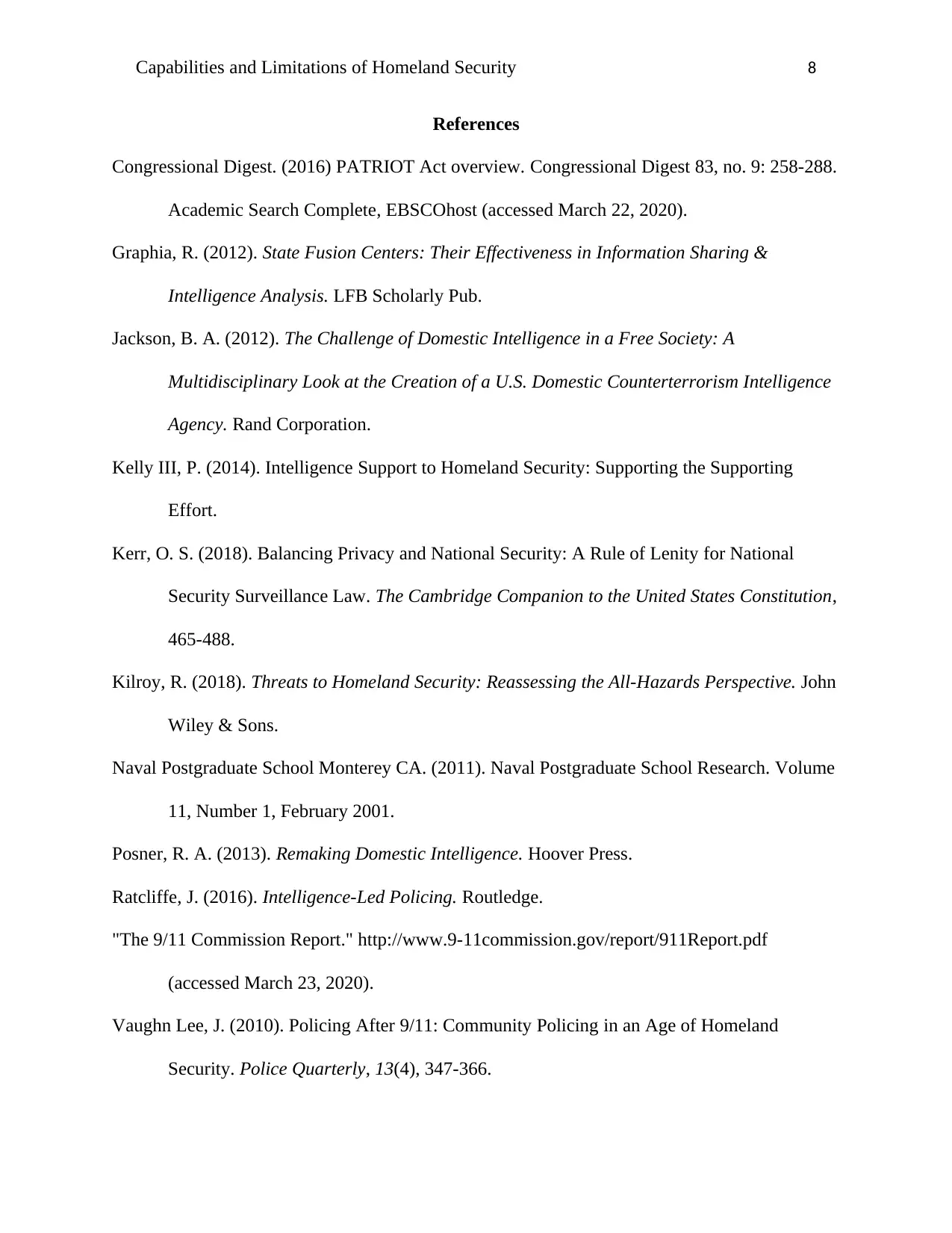
Capabilities and Limitations of Homeland Security 8
References
Congressional Digest. (2016) PATRIOT Act overview. Congressional Digest 83, no. 9: 258-288.
Academic Search Complete, EBSCOhost (accessed March 22, 2020).
Graphia, R. (2012). State Fusion Centers: Their Effectiveness in Information Sharing &
Intelligence Analysis. LFB Scholarly Pub.
Jackson, B. A. (2012). The Challenge of Domestic Intelligence in a Free Society: A
Multidisciplinary Look at the Creation of a U.S. Domestic Counterterrorism Intelligence
Agency. Rand Corporation.
Kelly III, P. (2014). Intelligence Support to Homeland Security: Supporting the Supporting
Effort.
Kerr, O. S. (2018). Balancing Privacy and National Security: A Rule of Lenity for National
Security Surveillance Law. The Cambridge Companion to the United States Constitution,
465-488.
Kilroy, R. (2018). Threats to Homeland Security: Reassessing the All-Hazards Perspective. John
Wiley & Sons.
Naval Postgraduate School Monterey CA. (2011). Naval Postgraduate School Research. Volume
11, Number 1, February 2001.
Posner, R. A. (2013). Remaking Domestic Intelligence. Hoover Press.
Ratcliffe, J. (2016). Intelligence-Led Policing. Routledge.
"The 9/11 Commission Report." http://www.9-11commission.gov/report/911Report.pdf
(accessed March 23, 2020).
Vaughn Lee, J. (2010). Policing After 9/11: Community Policing in an Age of Homeland
Security. Police Quarterly, 13(4), 347-366.
References
Congressional Digest. (2016) PATRIOT Act overview. Congressional Digest 83, no. 9: 258-288.
Academic Search Complete, EBSCOhost (accessed March 22, 2020).
Graphia, R. (2012). State Fusion Centers: Their Effectiveness in Information Sharing &
Intelligence Analysis. LFB Scholarly Pub.
Jackson, B. A. (2012). The Challenge of Domestic Intelligence in a Free Society: A
Multidisciplinary Look at the Creation of a U.S. Domestic Counterterrorism Intelligence
Agency. Rand Corporation.
Kelly III, P. (2014). Intelligence Support to Homeland Security: Supporting the Supporting
Effort.
Kerr, O. S. (2018). Balancing Privacy and National Security: A Rule of Lenity for National
Security Surveillance Law. The Cambridge Companion to the United States Constitution,
465-488.
Kilroy, R. (2018). Threats to Homeland Security: Reassessing the All-Hazards Perspective. John
Wiley & Sons.
Naval Postgraduate School Monterey CA. (2011). Naval Postgraduate School Research. Volume
11, Number 1, February 2001.
Posner, R. A. (2013). Remaking Domestic Intelligence. Hoover Press.
Ratcliffe, J. (2016). Intelligence-Led Policing. Routledge.
"The 9/11 Commission Report." http://www.9-11commission.gov/report/911Report.pdf
(accessed March 23, 2020).
Vaughn Lee, J. (2010). Policing After 9/11: Community Policing in an Age of Homeland
Security. Police Quarterly, 13(4), 347-366.
1 out of 8
Related Documents
Your All-in-One AI-Powered Toolkit for Academic Success.
+13062052269
info@desklib.com
Available 24*7 on WhatsApp / Email
![[object Object]](/_next/static/media/star-bottom.7253800d.svg)
Unlock your academic potential
Copyright © 2020–2025 A2Z Services. All Rights Reserved. Developed and managed by ZUCOL.




